PhysX Performance Update: City of Villains
by Ryan Smith on September 7, 2006 6:00 AM EST- Posted in
- GPUs
PhysX Performance
As we mentioned previously, even with demo recording, City of Villains does not recreate the exact same scenario every time (similar to Oblivion), so any benchmarks under CoV will still have a higher variance than normal. In order to get a better approximation of performance, every benchmark has been run multiple times, but a 1-2 FPS difference is still within the normal variance. As we noted in our previous article, CoV is a CPU-limited application, so we'll stick with the highest resolution.
For these tests, we have run them both with only a single and both cores of our Core 2 Duo X6800 in order to illustrate the impact of the second core.
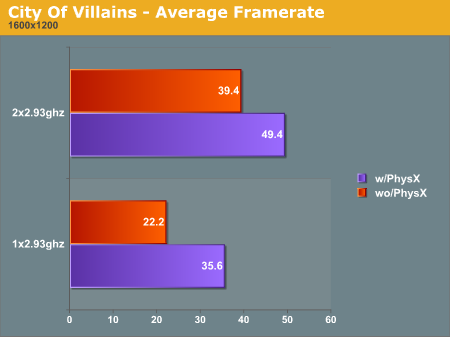
With the changes offered by Cryptic, the tables have turned significantly on the performance results. Now that we can use the same physics quality with both software and hardware rendering, it's easy to see just how loaded down the processor is when trying to perform the exact same physics calculations the PhysX card is. For our dual-core X6800 at full speed, using the PhysX card offers an average framerate about 25% higher than without, and on our X6800 running with just one active core, that jumps up to a 60% difference.
It's interesting to note the impact of the second core in relation to the PhysX card. While the card clearly offers a performance boost in all situations, the disparity between the boost of a dual-core system and a single-core is rather remarkable. Against a single-core system, the PhysX card is increasing performance by about 60%, but adding a second core instead of a PhysX card adds an even larger 77%. Granted, our single-core setup is slightly contrived, as Intel won't be selling a single-core Core architecture CPUs at this speed grade, but there are numerous systems out there currently running single-core processors where a dual-core processor could simply be dropped in.
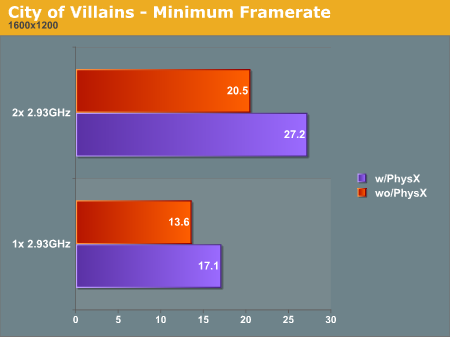
Switching to taking a look at the minimum framerate, the results are nearly identical. The physics calculations being done for CoV have a large impact on performance resulting in the PhysX card boosting performance by 35% on the dual-core setup. However, the overhead from other parts of the engine start to catch up to the single-core setup, where the performance boost is only 25%. Again, relative to the single-core configuration running software PhysX algorithms, adding the second core offers a larger boost than adding a PhysX card. The dual-core software PhysX calculations are 11% faster in average frame rates and 20% faster in minimum frame rates than a single-core processor with hardware PhysX.
Given the performance boost offered by the second core, we thought that perhaps the PhysX card could be more competitive on a dual-core system with a slower clock speed. We downclocked our X6800 to 1.86ghz to find out.
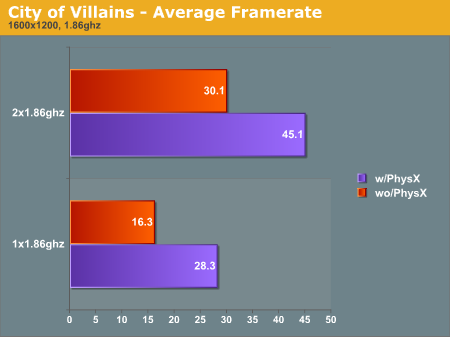
Since reducing the clockspeed of our CPU doesn't directly reduce the performance of the PhysX card, we find that our earlier theory is correct and that the PhysX card adds a hearty 50% with two cores functioning, and 73% with one core. Both results are greater than what we saw with a 2.93 GHz CPU. However, adding the second core also has a larger effect, this time at about 85% faster than a single core, although the dual-core setup is now only 6% faster than a single core with hardware PhysX.
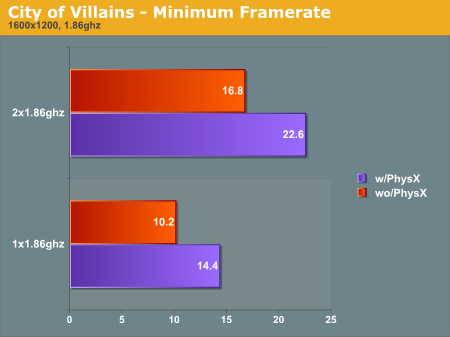
Returning to the minimum framerates, the numbers are somewhat similar to our earlier minimums, with a boost of 35% against a dual-core setup and 41% against the single-core, indicating that the speedup offered by the PhysX card is somewhat greater even with the additional overhead encountered by the slower single-core setup. Adding the second core without the PhysX card comes in at a 57% performance increase relative to a single core, which is 17% faster than the single core with a PhysX card.
Last but not least, how about the performance when the CPU is allowed to cheat a bit and use approximate physics calculations? As we mentioned before, only the highest physics mode pushes software and hardware to the same level of precision. The next-highest mode allows the software to run faster by using estimations rather than doing the full calculations, as well as generating a lower amount of debris.
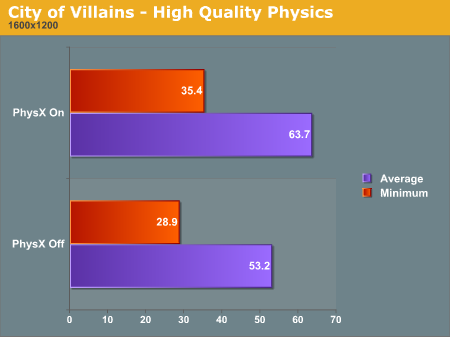
Even given the chance to cheat some, we still can't match the performance of using a PhysX card with a dual-core processor. The spread does drop to only 20%, but the setup using the PhysX card clearly takes the lead. It is worth noting however that the quality between these two modes is extremely close, even with the CPU using only physics approximations.
The highest quality mode still offers a superior amount of "stuff", and in turn the PhysX card does a better job of running that mode. The two modes are not easy to tell apart, though, and even less so in the middle of combat where such minor differences can easily be missed. If you compare the high-quality software PhysX scores on the dual core processor to the maximum quality hardware PhysX scores on the same setup, high-quality software PhysX ends up being slightly faster. Dropping the physics quality down a notch instead of buying a PhysX card is a perfectly viable alternative if extra performance is desired without spending any more money.
These numbers also show that even with our Core 2 Extreme processor, CoV is CPU limited both with and without the PhysX card. (You can also see this by referring back to the resolution scaling with ATI and NVIDIA cards on the previous page, for the 7900 GTX performance remains flat despite increasing resolutions.) What this means is that in these situations, the PhysX card is only useful up to the point where it's offloaded all the physics processing it can. Past that the bottleneck remains the CPU.
As we mentioned previously, even with demo recording, City of Villains does not recreate the exact same scenario every time (similar to Oblivion), so any benchmarks under CoV will still have a higher variance than normal. In order to get a better approximation of performance, every benchmark has been run multiple times, but a 1-2 FPS difference is still within the normal variance. As we noted in our previous article, CoV is a CPU-limited application, so we'll stick with the highest resolution.
For these tests, we have run them both with only a single and both cores of our Core 2 Duo X6800 in order to illustrate the impact of the second core.

With the changes offered by Cryptic, the tables have turned significantly on the performance results. Now that we can use the same physics quality with both software and hardware rendering, it's easy to see just how loaded down the processor is when trying to perform the exact same physics calculations the PhysX card is. For our dual-core X6800 at full speed, using the PhysX card offers an average framerate about 25% higher than without, and on our X6800 running with just one active core, that jumps up to a 60% difference.
It's interesting to note the impact of the second core in relation to the PhysX card. While the card clearly offers a performance boost in all situations, the disparity between the boost of a dual-core system and a single-core is rather remarkable. Against a single-core system, the PhysX card is increasing performance by about 60%, but adding a second core instead of a PhysX card adds an even larger 77%. Granted, our single-core setup is slightly contrived, as Intel won't be selling a single-core Core architecture CPUs at this speed grade, but there are numerous systems out there currently running single-core processors where a dual-core processor could simply be dropped in.

Switching to taking a look at the minimum framerate, the results are nearly identical. The physics calculations being done for CoV have a large impact on performance resulting in the PhysX card boosting performance by 35% on the dual-core setup. However, the overhead from other parts of the engine start to catch up to the single-core setup, where the performance boost is only 25%. Again, relative to the single-core configuration running software PhysX algorithms, adding the second core offers a larger boost than adding a PhysX card. The dual-core software PhysX calculations are 11% faster in average frame rates and 20% faster in minimum frame rates than a single-core processor with hardware PhysX.
Given the performance boost offered by the second core, we thought that perhaps the PhysX card could be more competitive on a dual-core system with a slower clock speed. We downclocked our X6800 to 1.86ghz to find out.

Since reducing the clockspeed of our CPU doesn't directly reduce the performance of the PhysX card, we find that our earlier theory is correct and that the PhysX card adds a hearty 50% with two cores functioning, and 73% with one core. Both results are greater than what we saw with a 2.93 GHz CPU. However, adding the second core also has a larger effect, this time at about 85% faster than a single core, although the dual-core setup is now only 6% faster than a single core with hardware PhysX.

Returning to the minimum framerates, the numbers are somewhat similar to our earlier minimums, with a boost of 35% against a dual-core setup and 41% against the single-core, indicating that the speedup offered by the PhysX card is somewhat greater even with the additional overhead encountered by the slower single-core setup. Adding the second core without the PhysX card comes in at a 57% performance increase relative to a single core, which is 17% faster than the single core with a PhysX card.
Last but not least, how about the performance when the CPU is allowed to cheat a bit and use approximate physics calculations? As we mentioned before, only the highest physics mode pushes software and hardware to the same level of precision. The next-highest mode allows the software to run faster by using estimations rather than doing the full calculations, as well as generating a lower amount of debris.

Even given the chance to cheat some, we still can't match the performance of using a PhysX card with a dual-core processor. The spread does drop to only 20%, but the setup using the PhysX card clearly takes the lead. It is worth noting however that the quality between these two modes is extremely close, even with the CPU using only physics approximations.
The highest quality mode still offers a superior amount of "stuff", and in turn the PhysX card does a better job of running that mode. The two modes are not easy to tell apart, though, and even less so in the middle of combat where such minor differences can easily be missed. If you compare the high-quality software PhysX scores on the dual core processor to the maximum quality hardware PhysX scores on the same setup, high-quality software PhysX ends up being slightly faster. Dropping the physics quality down a notch instead of buying a PhysX card is a perfectly viable alternative if extra performance is desired without spending any more money.
These numbers also show that even with our Core 2 Extreme processor, CoV is CPU limited both with and without the PhysX card. (You can also see this by referring back to the resolution scaling with ATI and NVIDIA cards on the previous page, for the 7900 GTX performance remains flat despite increasing resolutions.) What this means is that in these situations, the PhysX card is only useful up to the point where it's offloaded all the physics processing it can. Past that the bottleneck remains the CPU.










31 Comments
View All Comments
Calin - Friday, September 8, 2006 - link
MMX and its successors were used to accelerate the hell out of many photoshop plug-ins (P4 in its worst days was faster running the optimised routines than Athlon64, and in many cases it was faster by a big amount).I think the video cards could be better at offloading this kind of calculation - maybe even more optimised routines will come soon (in many cases, graphic professionals use top-of-the-line cards, or even workstation-builds like NVidia Quadro and ATI FireGL)
Calin - Thursday, September 7, 2006 - link
Using Ageia PPU gives you about 35% or more extra performance in CoV, or 6fps. Using a dedicated sound card instead of a lowly integrated sound will give you 6fps in benchmarks of the Quake3 or so engines, for a 5% or so difference in frame rate. For just this purpose, PPU is better than a dedicated sound card (even if more expensive)DerekWilson - Thursday, September 7, 2006 - link
I can find a more expensive audio solution for you :-)But this is true -- percent difference is what we need to look at here.
Calin - Friday, September 8, 2006 - link
You could find a more expensive audio solution certainly - but I don't think you would be able to reduce the frame rate as compared to a $200 Creative 7.1 Channel Sound Blaster X-Fi Fatal1ty FPS (the price from Anandtech's own RealTime Pricing).Anyway, thanks for the article - nice written, and interesting. Thumbs up!
Marlin1975 - Thursday, September 7, 2006 - link
How abotu trying the PhysX on a board that has intergrated graphics? Would it help those stuck with pos intel onboard or even the better Ati/Nvidia onboard graphics? Onboard usually covers 2d ok and has some 3d, but maybe with a little help onboard can move up with little cost. (cost as in when the PhysX comes down to the real world in pricing)?Lonyo - Thursday, September 7, 2006 - link
Also, for less than the price of a PPU you can get a 7900GT.If you want to try and suggest a PPU is better than a 7900GT as an upgrade, well, hmm.
PrinceGaz - Thursday, September 7, 2006 - link
If a game is totally GPU limited (as is usually the case with onboard graphics), then a physics-card will make no difference whatsoever to performance.The PhysX card offloads work from the CPU, it does not offload any work from the GPU, so the PhysX card will not help people using onboard/slow graphics solutions.
Calin - Thursday, September 7, 2006 - link
Also, a physics card "creates" more debris, which is not only physics intensive to compute (paths and so on), but GPU intensive to render.Anyway, integrated graphics usually reduce the quality and resolution of possible gaming - using the money for the physics card for a new (or additional) graphic card would be the cheapest solution to fast, quality gaming. Not to mention you could get multimonitor capabilities in the price, maybe DVI and so on.
DerekWilson - Thursday, September 7, 2006 - link
This is quite true ... if you don't have a gpu that can handle what you are already throwing at it, a PhysX card won't do much. Sure it'll take off some CPU load, but chances are you aren't cpu limited. And if you tried turning up the debris settings you'd just be adding to the load on the GPU. Which could cause some performance decrease.We will keep this in mind for future tests and try to address the issue later. For now, it's safe to assume that you'll need at least a midrange quality graphics board to gain anything from PhysX.
yyrkoon - Thursday, September 7, 2006 - link
I think you'd have to be insane to think that running a game on a system with onboard video is going to do well in a Physics intensive game . . .